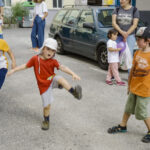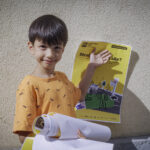Park(ING) Day for Fitness
Physical activity in the urban environment






Project partners included Placemaking Europe (NL), Sport for All (RO), VSport (PL), Azur Spor Sante (FR), and XsentrikArts (AT).
Funded by the European Union and co-ordinated by BG Beactive; Park(ING) day for Fitness is a sports project that transforms public spaces into pop-up sports spots. The goal of the project is to promote an active lifestyle in our built environment.
As the Austrian partner, we were active in the Viennese districts of Meidling, Favoriten, Fünfhaus, and other Viennese districts – transforming urban zones into activity areas. We had the pleasure of working with local organizations such as Loginsleben, Wiir, Cycle Cinema, Mei Meidling and Space and Place.
We combined storytelling with the promotion of physical activity in our own Xsentrik manner and created a series of films.
“Vienna is a unique site for such activities: the emergence of Wohnstrassen in recent years (streets considered by law a public space made available to citizens to use), actively encourages citizens to take ownership of their streets.”
The story
We began our efforts months in advance and worked steadfast leading up to the events. Liaising with organizations, contacting local authorities, and getting all our “ducks in order” took considerable effort and planning. Yet we learned, developed capacities and adapted our methodology along the way.
Vienna - a unique place
We began our efforts months in advance and worked steadfast leading up to the events. Liaising with organizations, contacting local authorities, and getting all our “ducks in order” took considerable effort and planning. Yet we learned, developed capacities and adapted our methodology along the way.
We had to adapt to the local reality
We worked in different districts and realized there were difficulties in adapting the concept to the local reality: more specifically, overcoming bureaucratic procedures to reserve parking spots in advance requires planning and human resources.
Most of the organizations we partnered with are grass roots organizations with limited means and resources; which means they required our active aid in clearing permissions.
Wohnstrassen - a healthy alternative
Local municipalities required an application at least a month in advance – which proved to be challenging for our partners. So we decided we could adapt the concept to Wohnstrassen with Place and Space, and worked with them to activate areas that were already made available by the city of Vienna for this purpose.
Storytelling as a tool for participation
Creating formats that are "Xsentrik" - film screenings
Finally: we also wanted to combine films and storytelling with fitness, so we created a diverse format in the form of public film screenings featuring a curated set of films focusing on our built environment – through a partnership with cycle-cinema Club.,
Now, onto the events and how all these materialized:
A summary of our events:
Reichgasse with Wiir
We began experimenting with methodology and collaboration techniques, via our partnership with Wiir: a local organisation dedicated to promoting healthy living and physical activity, more notable among youngsters and children. They created a parkour on Reschgasse, a street adjacent to Meidling’s famous Meidlinger Markt. The challenge was in the form of an obstacle course , on the street. The three hour long session also included some shoulder and bodyweight strengthening exercises for adults. You can view the event video here.
In short:
- In Vienna’s vibrant Meidling district
- Two partners: Mei Meidling and Wiir
- We closed off three spots and created an obstacle course
Loginsleben Festival in the 15th
We joined LoginsLeben in the 15th District, where we joined their anniversary celebrations. The street was shut down, and reserved for festivities, which included food, a live music band, and activities. We offered table tennis, boxing and dancing activities on the street.
Mei Meidling and the Klima-Grätzl Fest
Our collaboration and our role as a connecting point between organisations continued in Meidling.
The Mei Meidling Klima Grätzl Fest is an event that closes down the streets in and around the Market of Meidling, to promote a green, accessible, inclusive city.
Over the two day festival, we partnered up with Wonderland Architecture to create unique games, such as paper airplane flying, guessing the language (to promote inclusiveness), and hop-scotch.
We also brought along Loginsleben and their activities, which included karate, fitness aerobics, and yoga.
Tagging into the event taking place, we were able to make contacts and promote physical activity on the street by reaching the locals and visitors to the event. We also brought along our Park(ING) Day boxing bag, which was a great hit, with youngsters and adults alike, cueing up for boxing tips and tricks. Wiir also joined and created their obstacle course, attracting the attention of not only the young, but our older residents as well. All in all, the events taking place in Meidling were a great success, providing us with a wide reach.
Film screening with cycle cinema club
Given that we’re an arts initiative, it would come as no surprise that we found the perfect collaborators for an unforgettable evening: The Cycle Cinema Club.
They’re a local organization promoting cinema and fitness through stationary bikes: three bikes are set up: they power the film projector. By doing so, we can promote activity as well as solidarity and inclusiveness. As xsentrikarts, we curated a series of films on transforming our urban environment: the screenings were followed by candid discussions on how to utilize public space, and what we can do to promote more activity in urban spaces.

Wohnstrassen with Space and Place at Burjan Platz (15th district).
We integrated Park(ING) day activities with the yearly festival of Space and Place. The Burjan Platz and the surroundings were utilized and we offered boxing training, Aerobics, rope jumping, hop-skotch and other activities with our trainers. The event occupied three P-Spots and livened the atmosphere on the wohnstrasse in the 15th.
Physical activity is a key factor of a healthy lifestyle and it should be practiced and accessible by a much larger share of the population. That is why the project also aims to highlight urban features of the public spaces of contemporary cities, such as Parking spots that can contribute to the promotion of physical activity among their residents.
With the above said, the main aim of the project is to increase the awareness of citizens of alternative possibilities to be active in their cities and provide creative opportunities to grassroots sports providers to promote and deliver active leisure offers. The Park(ing) Day for Fitness (PDF) will show how to use the potential of public spaces for practicing safe outdoor physical activity to improve the physical and mental health of citizens.
View the films
Given that we use storytelling and visual research as a vital tool in promoting exchange and know-how, it should come as no surprise that we created a few for our Park(ING) Day activities here in Vienna, as well.
The films tell the stories of Park(ING) day activities in Vienna, and of the amazing organizations we had the pleasure of working with!
More on the project.... Who do we target?
The project targets the citizens overall, as the ones to engage in physical activity in public spaces, and operationally targets sports clubs and grassroots sports operators as the activators and the implementing group of the event concept. The project also targets urban designers and municipalities to share with them all of the alternative ways they can plan and design for the use of public spaces.
The design of our buildings, streets, neighborhoods, and cities often makes physical activity unnatural and difficult to achieve – for example, unsafe or arduous pedestrian crosswalks, cars, concrete materials, etc. Creating opportunities for exercise in daily life routines can increase physical activity and assist in controlling epidemics related to obesity, as well as contribute to environmental sustainability and safe physical activity. A report to the European Commission on innovative practices to promote sport outside of traditional structures (March 2021) highlights the concept of ‘active spaces’ to tackle the sedentary problem and improve well-being through making use of the built environments (buildings, green spaces, etc.) made by people[1].
This data suggests that physical activities are becoming more and more detached from typical sports facilities and there is a need to envisage the potential of public spaces for the grassroots sports ecosystem. With that on our minds, we are taking the Park(ing) Day concept and transforming it into the Park(ing) Day for Fitness programme as the gateway to be physically active in urban environments, and as a tool to adapt grassroots sport for current realities and the evolving social needs.
Why Parking spots?
Parking spaces are an under-appreciated land use type in our otherwise vibrant cities. What’s more, they could be rented cheeply, at just a few coins per hour and become anything for a duration of hours. On what has once been concrete, a living grass could be rolled up, a treadmill could be installed, a few yoga mats could be placed, a potted tree or – why not – a tennis table
The re-imagined Parking spots are creating an opportunity:
● for fun leisure sport activities outside the standard setting and this provides a sense of novelty and excitement.
● for advocating for more places for people, not cars.
When Parking spots are re-imagined, they demonstrate the dominance of the cars in the streets.
Park(ing) day for fitness is a project that will continue to grow each year. Currently, we have partners in 5 countries, meaning the events will be taking place simultaneously in the following countries:
France, Bulgaria, Austria, Romania, Holland
Why do we want to cooperate with grass roots organizations?
In WHO’s publication “Towards more physical activity in cities” there are several studies, in which the built environment has consistently been shown to affect the level of physical activity among the population; thus, there is much scope to use the setting of the city to increase opportunities for physical activity. In light of this, WHO and other bodies have recommended that the discipline of urban planning should consider the needs of the population in terms of physical activity, and this has been strongly reflected in the well-defined concept of a “healthy city” (WHO).
We’d like to work with grassroots organizations so we can create a database of knowledge and knowhow, and pass on the necessary information to the governing and planning bodies so the city can be better situated and planned to promote physical activity.
The potential of healthy public spaces is best measured by its functionality. Sport and physical activity represent a natural way to give a meaning to public spaces and make them attractive for a larger audience.
